Geography of Russian epics of the Kyiv cycle
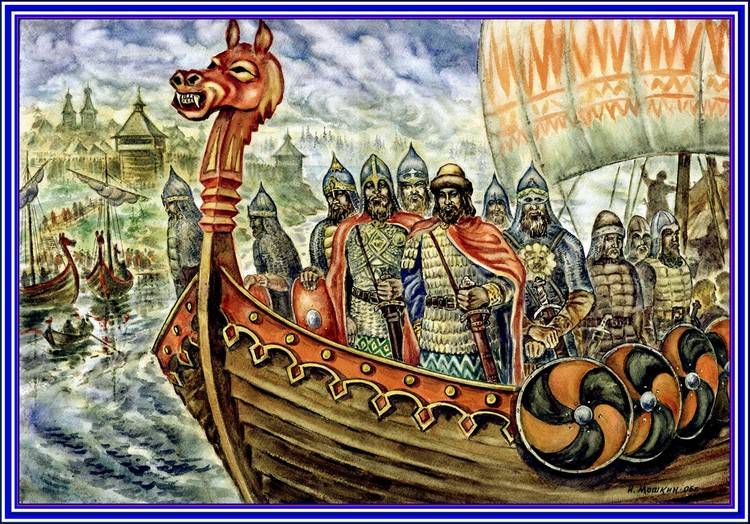
Illustration by I. Moshkin
A paradox has long been noticed: Russian heroic epics (old times), often telling about events in the southern and western Russian principalities, are completely forgotten precisely in these areas that fell into the sphere of Polish-Lithuanian influence. Belarus and Little Russia did not remember Ancient Russia. The heroic “old men” were also forgotten in the Westernizing ruling class of Russia. Its representatives treated with contempt the "common people" and his work.
Recall that A. S. Pushkin wrote his first poems in French. For him, the tales told to him during his exile by the peasant woman Arina Rodionovna, the nanny of his mother and older sister Olga, became a revelation (the poet's nurse and nanny was another woman). Epics were rediscovered by the Russian nobility and the educated public only in the middle of the 300th century. It turned out that they are still remembered in the Great Russian provinces, especially in the Russian North, which experts sometimes call the "Iceland of the Russian epic." Most of the "stars" were recorded in the Olonets province - XNUMX.
But the epics of the "Kyiv cycle" were also recorded in the Arkhangelsk province (34), Siberia (29), Simbirsk province (22), Saratov (10), Nizhny Novgorod (6) and Moscow (3). However, it should be remembered that for a number of centuries epics existed only in oral form. In this they differ from the Scandinavian sagas, which were already written down in the XNUMXth century. And therefore, the epics heard in the middle of the XNUMXth century, of course, differ significantly from the epics of the XNUMXth or XNUMXth century.
Some information and plots were probably lost over the years, and some, on the contrary, were introduced by later storytellers who tried to make their stories more relevant, topical and, therefore, more interesting for listeners. Olonets, Arkhangelsk and other Russian storytellers had a very remote idea of the geography of the southern Russian principalities. Their listeners were also not surprised by the stories about how some heroes from Kyiv along the Volga suddenly end up in Tsargrad.
Nevertheless, since the appearance of the "Collection of Kirsha Danilov" (the first records of Russian epics), researchers have made attempts to identify objects of epic geography with quite real ones.
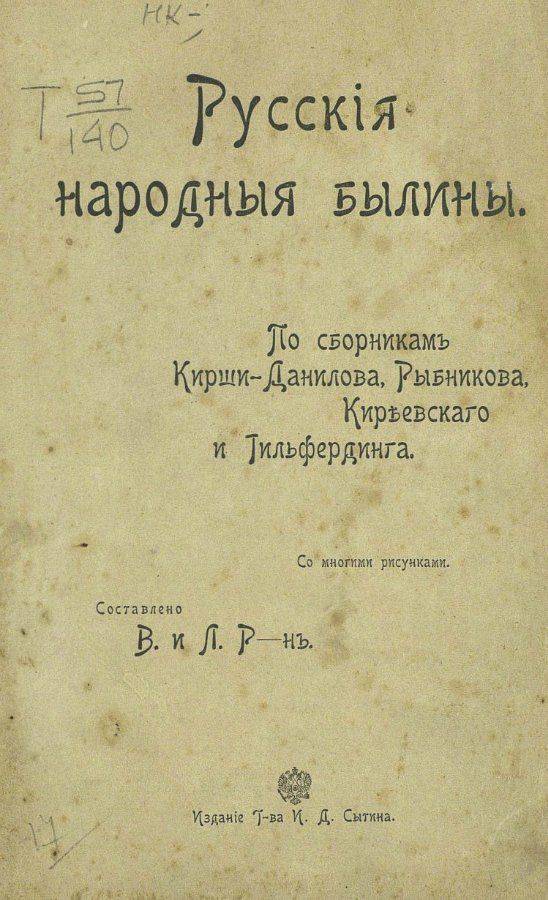
Russian folk epic, publication of the Sytin partnership
Some of these objects will be discussed in this article.
Options for maps of the epic world:
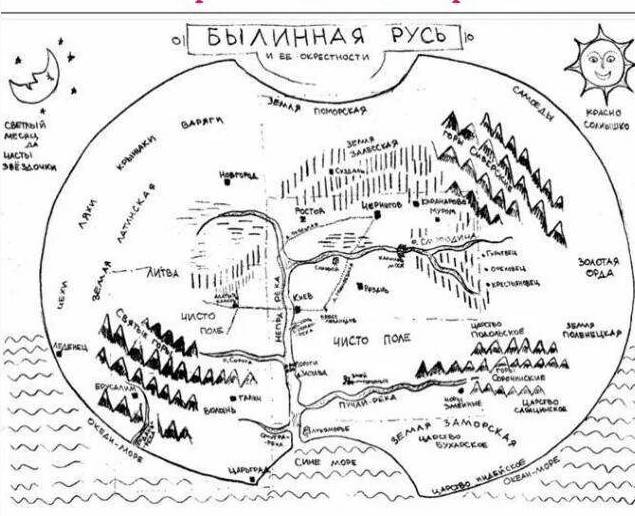
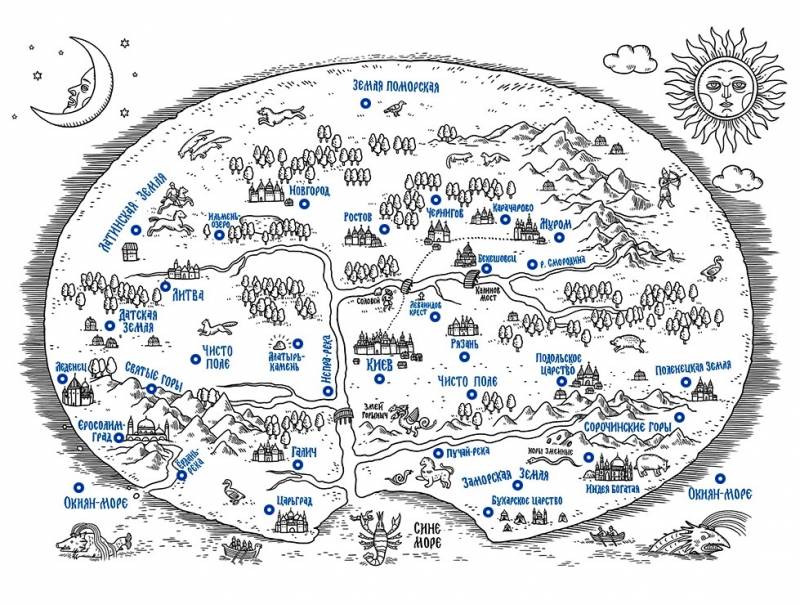
Epics of the Kyiv cycle
The action of this group of epics is always somehow tied to Kyiv, although the main action may take place far from it. But the hero either leaves Kyiv, or goes to him, or fulfills the order of the Kyiv prince Vladimir.
And these epics are the most fantastic, many of them are more like fairy tales.
The epic Kyiv itself and its location sometimes have nothing to do with reality. From Kyiv to Chernigov, some heroes sail along the sea, and from Kyiv to Tsargrad - along the Volga.
puchay river
The Puchay River in epics is described as very distant, dangerous and "fiery". Meanwhile, many researchers believe that the Pochaina (the right tributary of the Dnieper), which flowed on the territory of modern Kyiv, was the prototype of this river. Kyiv local historian A. Morina in 2015 suggested that the former channel of the Pochaina is the Obolon system of lakes Opechen.
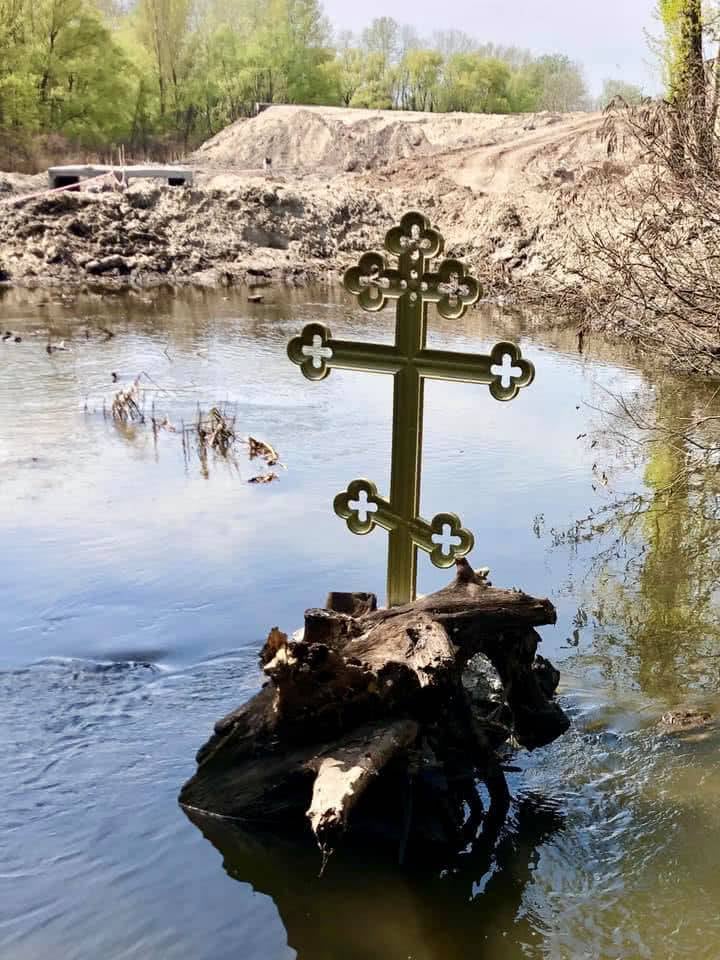
Proposed Pochaina River, Kyiv
It was in this river, contrary to the prohibition of his mother, that Dobrynya Nikitich swam - and here the Serpent Gorynych took him by surprise. And on the banks of the same border river, Dobrynya met his future wife, Nastasya Mikulichnaya, who “pulled him off the saddle” - this is how they say about captivity with the help of a lasso.
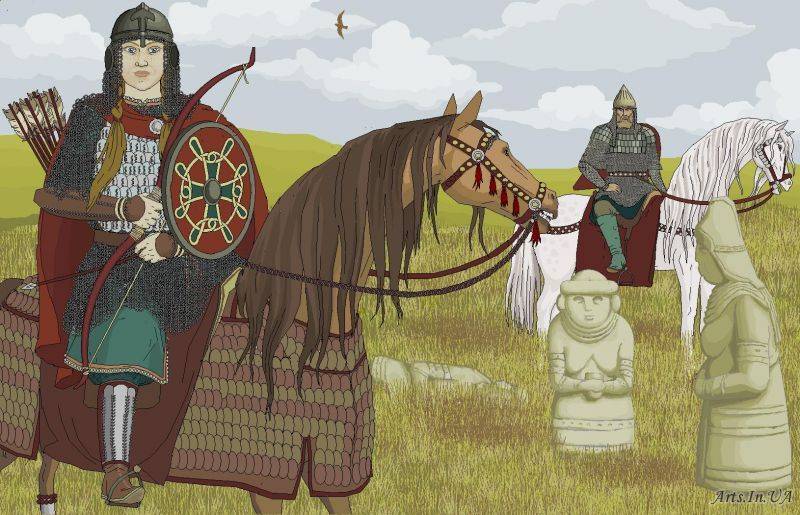
Nastasya Mikulichna and Dobrynya Nikitich illustrated by S. Voronov
That is, Nastasya was a girl from some nomadic tribe, and even a pagan: she was already baptized in Russia - before the wedding.
Ideas about Pochaina as a very distant and dangerous river testify to the early time of the emergence of this epic.
I must say that rivers in epics often serve as a border not only between different peoples, but also between worlds. So Mikhail Potyk (Novgorod bogatyr, who became the hero of the epics of the Kyiv cycle) on the banks of the Puchai River (Pochayna) met a girl from another world - the sorceress Avdotya the White Swan, the daughter of the Podolsk king Vahramey.
This kingdom was not the most distant - it bordered on the Clear Field and was separated from the Overseas kingdom by the Sorochinsky mountains. The daughter of the Podolsk king became the wife of a hero, but Potyk was much less fortunate than Dobrynya. Avdotya soon died in order to revive her wife, Potyk followed her into the grave and killed the Serpent guarding her.
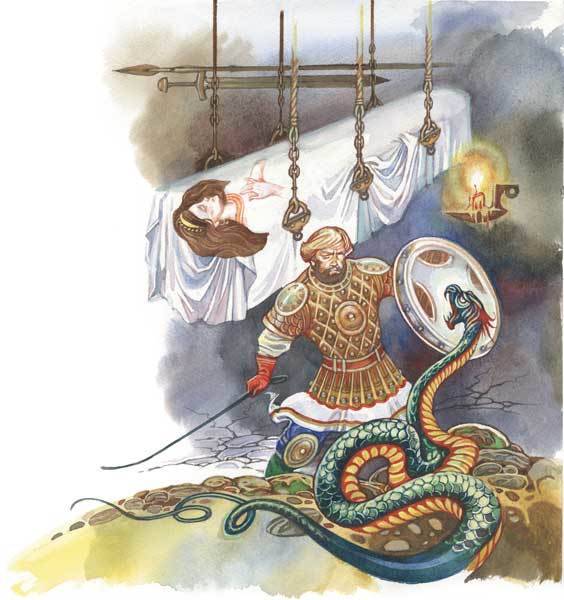
Mikhail Potyk fights with the Serpent in the grave of his wife, illustration to the epic
He did not wait for gratitude from Avdotya: the wife, who returned to life, fled to Koshchei the Immortal and, together with him, almost killed the hero.
Smorodina River
But much more famous as the border between the worlds is the famous Smorodina River. Since the epic about Ilya Murom says that it was on its bank near the Black Mud that the Nightingale the Robber settled, some researchers believe that we can talk about the left tributary of the Dnieper Samara (Sneporod). But it lies much to the south of the road from Chernigov to Kyiv and, thus, the road chosen by Ilya Muromets cannot be "straight" in any way.
Perhaps later storytellers corrected the plot, and in fact Ilya purposefully turned south to capture Nightingale and present him to Prince Vladimir - they say, you are not dealing with a simple village peasant, but with a real hero. But, perhaps, the reason is the elementary ignorance of the northern narrators of the geography of the southern principalities, which is not at all surprising.
Chernigov, according to epics, was located very close to Murom. This is probably due to the memory that the Ryazan-Murom land at first belonged to the Chernigov princes and only later was allocated to a separate principality.
But much more often, both in epics and fairy tales, Currant appears as a river separating the world of the living from the kingdom of the dead, and its name comes not from a berry bush, but from the word "stench". And the Nightingale, apparently, was not an ordinary robber (and who did he have to rob if the road to Smorodina had long been overgrown with weeds?), But a guard guarding the passage between the worlds.
In Russian fairy tales, they also talk about the Kalinov Bridge, which is thrown across this river. In fact, this bridge is not made of thin branches of viburnum - it is "viburnum", that is, "hot".
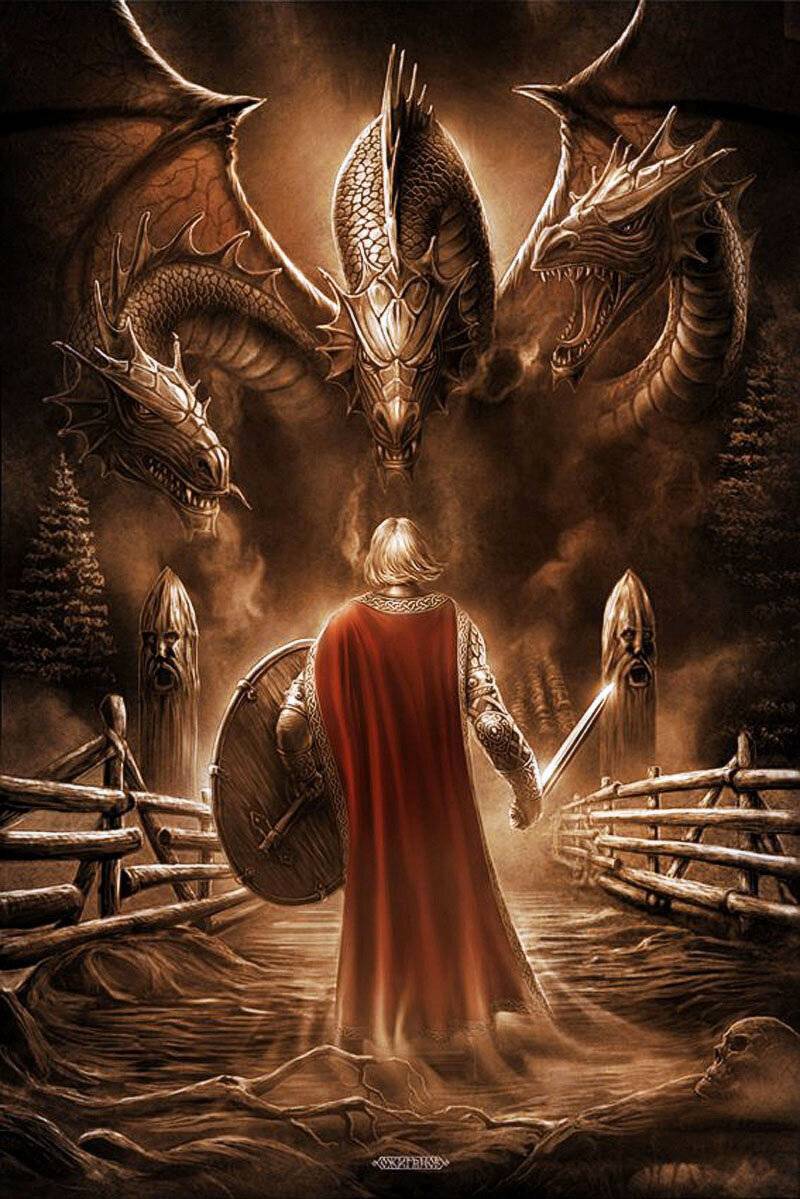
I. Ozhiganov. Kalinov bridge
This is already the influence of Christian ideas about hellish hell, through which, apparently, a bridge will be thrown. But the authors of fairy tales also remember the Serpents of Russian epics, with which another main character is already fighting: Ivan is a peasant son. And these Snakes are probably Polovtsy, and the number of their heads corresponds to the number of tribes that took part in the raid. S. Pletneva, for example, pointed out that the name of the Kai tribe, which was at the head of the Polovtsian union, means “snake”.
Arabic and Chinese authors knew the proverb “the snake has seven heads” (according to the number of the main Polovtsian tribes) - it is repeatedly found in their writings. Russian chroniclers, it seems, also heard it, about the victory of Vladimir Monomakh over the Polovtsy in 1103 it is said:
And Tugarin Zmeevich, even in epics, is described precisely as a foreign hero.
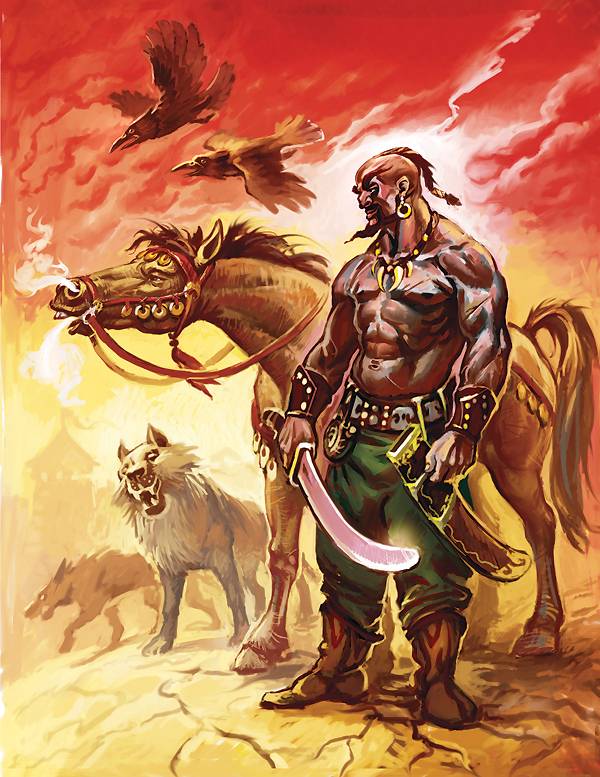
Tugarin Zmeevich illustrated by V. Sluzhaev
Nepra
Another border river of Russian epics of the Kyiv cycle is the Nepra, which is “twenty sazhens deep, forty sazhens wide”, but serves as an insurmountable obstacle for the Tatars, washing away the bridges they built. Some believe that Nepra is the Dnieper. Of course, the small size of the river is embarrassing, but the Dnieper in the same Smolensk can be very disappointing.
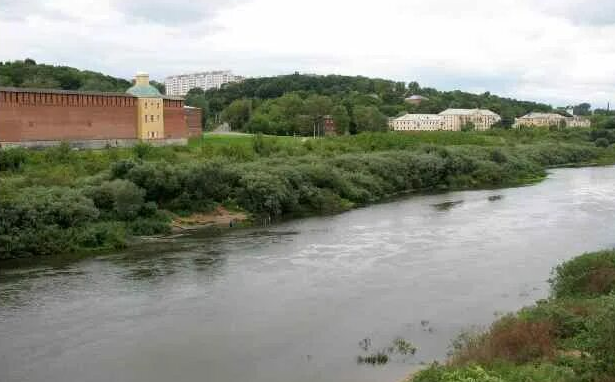
Dnipro in Smolensk
Bylina connects this river with the wife of the hero Danube Ivanovich - Nastasya. According to one version of this epic, she was the Lithuanian queen and elder sister of Evpraksa, the wife of Prince Vladimir. While pregnant, Nastasya died from the arrow of a drunken husband who decided to demonstrate his accuracy to everyone. From her blood, the river Nepra was formed.
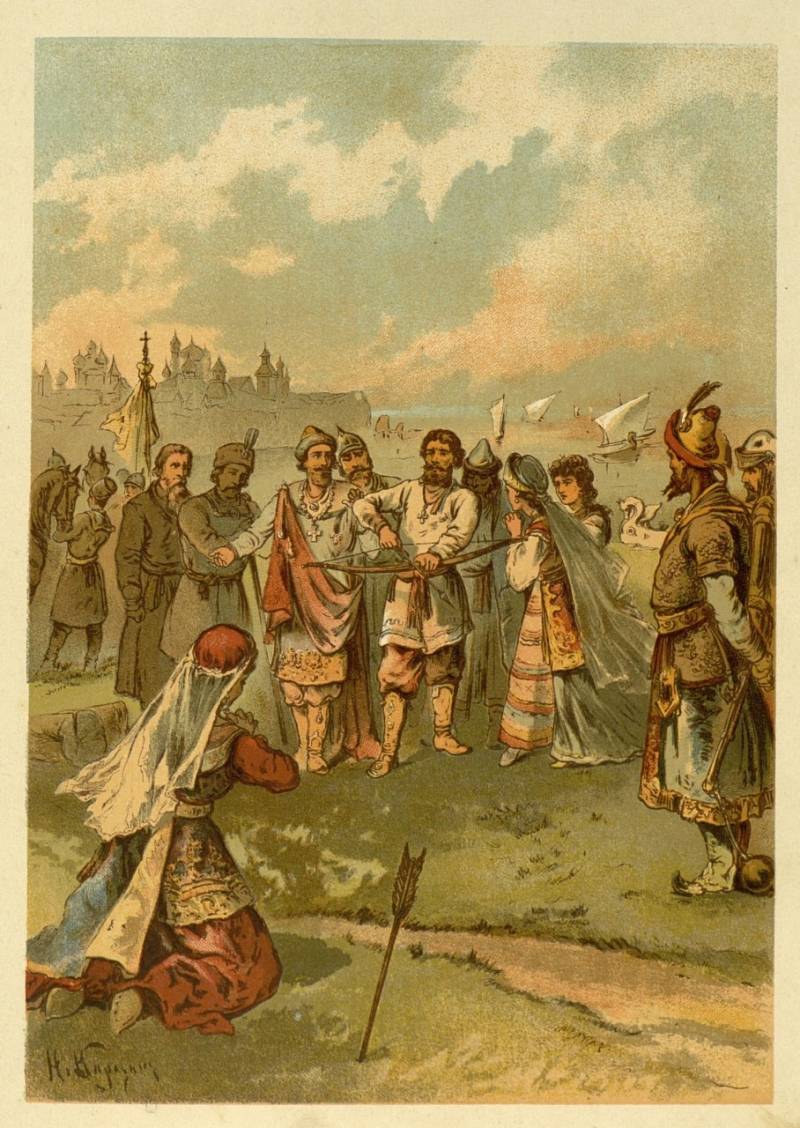
Danube Ivanovich kills his wife during a contest for accuracy
The Danube then rushed to the sword, epics connect the appearance of the Danube River, which is very far from Kyiv, with his blood.
Lithuania Russian epics
Lithuania in epics appears as the Lyakhovinsky kingdom, can be characterized as “good”, “cursed” and “filthy”. In the latter case, apparently, there is a difference in faith. Lithuania remained pagan for a long time, and then the dominant religion there was Catholicism, not Orthodoxy.
And the Latin land in the epics appears as an absolutely alien territory where good stallions are raised. It was from Lithuania that Dobrynya Nikitich and Danube Ivanovich brought Evpraksa, the wife of Prince Vladimir.
Not far from Kyiv was also the epic kingdom of Bukhara, which Mikhail Potyk, already familiar to us, once won against the “overseas king” in checkers.
Memories of Tmutarakan?
Very interesting is the voyage along the Black Sea of the hero Ivan Godinovich (epic "Ivan Godinovich and Koschey the Immortal"), who in this way got from Kyiv to Chernigov. If we assume that the narrator in this case did not confuse anything, this situation can be understood only by assuming that the hero, after a campaign against the Pechenegs or Polovtsy, returns to Russia in a roundabout way - through Tmutarakan, which was for some time under the rule of the Chernigov princes. Then, perhaps, having descended along the Dnieper to the Black Sea, the Kyiv squad passed along its coast and ended up in the Tmutarakan possessions of Chernigov. Here the hero married a girl betrothed to Koshchei the Immortal. According to one version, Koshchei in Russia at that time was called the Polovtsian khans.
As confirmation, supporters of this version cite the lines of the "Words about Igor's Campaign" that after the capture, Igor had to sit "in the sdlo Koshchievo", that is, the Khan's - he mounted a horse provided to him by Konchak. The version that the “koshchivo saddle” is a slave one does not find confirmation in the further story, where Igor and his son Vladimir are actually Konchak’s guests and even freely go hunting (accompanied by an honorary retinue). And how much have you heard about slaves who are put on horses?
It is believed that Igor's strange "flight" was a staging. His son Vladimir not only did not undergo any repressions, but got Konchak's daughter as his wife, with whom, after the birth of a child, he was honorably sent to Russia without any ransom.
Let's return to the epic about Ivan Godinovich. The way home from Tmutarakan, surrounded by nomads, lay through the lands of the Eastern Polovtsy (the ancestors of Sharukan and his grandson, Konchak). And the young couple could not avoid meeting with the former groom, who began to make claims, and then, being defeated, turned to the former bride with the words that she had made a big mistake by exchanging him - the sovereign tsar (khan?) for a servant of the Kyiv prince. As a result, Ivan Godinovich was betrayed by his wife.
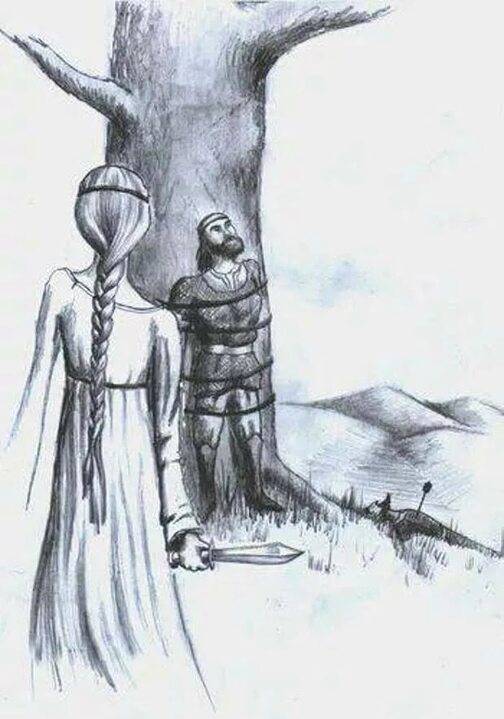
Betrayed by his wife Ivan Godinovich, illustration for the epic
He was able to escape only thanks to the intervention of supernatural forces.
Indirect evidence in favor of this version can be the traditionally close ties of the Chernigov and Tmutarakan princes with the Polovtsians.
Holy mountains, Svyatogor and Ilya Muromets
It is impossible not to notice that the features of two different heroes merged in the image of Ilya Muromets.
The first of them, apparently, was not Muromets, but Muravlyanin or Moravyanin. This is clearly a professional warrior who came to Russia from the west, possibly from the same Moravia. Until then, he traveled through the Holy Mountains, which were located quite far from Russia.
The holy mountains may be the Carpathians, but attempts were made to identify them with the Ararat highlands, and the hero Svyatogor, whom Ilya met, with Sanasar, one of the heroes of the Sasna Tsrer epic. However, this epic began to be translated into Russian only in the second half of the XNUMXth century, and it is unlikely that illiterate storytellers of the Olonets or Arkhangelsk provinces were familiar with these translations. As for the origin of Svyatogor, in a single epic he is called the hero of the Chernigov prince.
And the wife of Svyatogor comes from some trading city connected with the sea - perhaps this is Novgorod, but maybe the Vendian Volin, which we will talk about later. It was from the dying Svyatogor that this Ilya (Muravlyanin) received the sword-treasurer and strength: Svyatogor twice "breathed him with a heroic spirit."
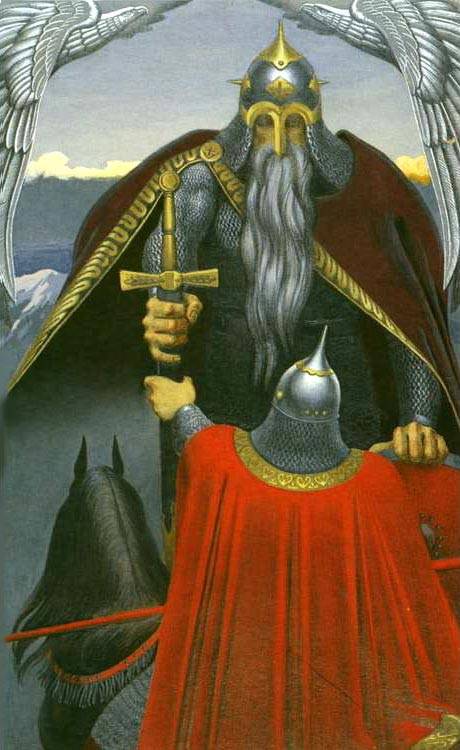
K. Vasiliev. Gift of Svyatogor
In Kyiv, this Ilya became the generally recognized leader and commander of the heroic squad. It was he who was portrayed by V. Fokeev (the artist of Palekh), illustrating the epic "Attack on the heroic outpost and the battle of Podsokolnik with Ilya Muromets."
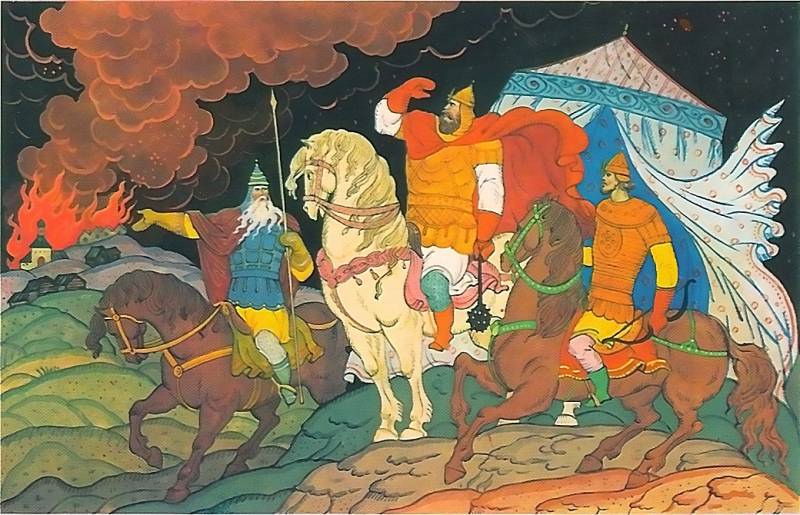
This Ilya has a proud commanding posture, rich armor and a scarlet cloak. We see a messenger who came to him with a report on the situation on the front line, and a deputy or orderly.
In general, we have a self-confident commander who makes an important decision. In the epics at the feasts of Prince Vladimir, he sits in a place of honor.
Tmutarakan again?
According to B. A. Rybakov, the epic about the death of Svyatogor is also connected with Tmutarkan. Although, as we remember, Svyatogora could not bear the earth, and therefore he was forced to live in the mountains. The Taman Peninsula hardly fits the description of the "Holy Mountains". However, Rybakov believed that Ilya and Svyatogor found an ancient necropolis on Taman, and the coffin in which Svyatogor lay down as a joke was a marble sarcophagus, similar to the one in the Moscow Historical Museum.
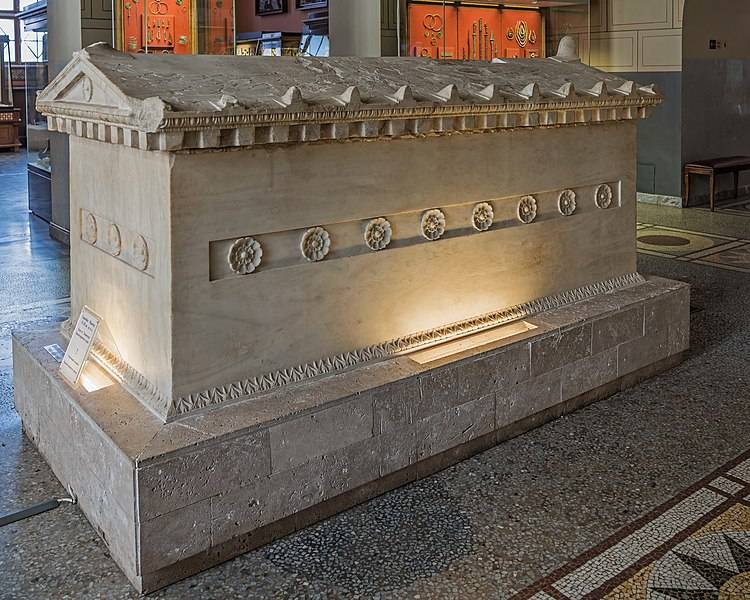
We see a very similar sarcophagus in this illustration, where Ilya tries in vain to cut its cover with a sword:
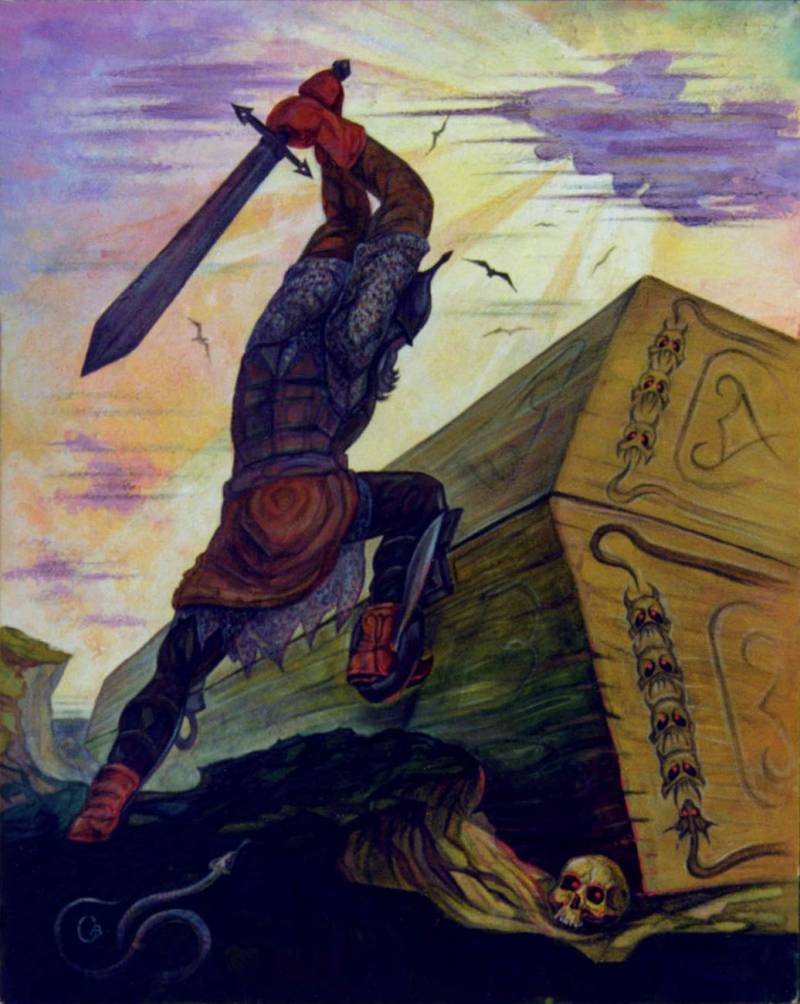
By the way, the lid of the same Taman sarcophagus weighs half a ton. It is not surprising that Ilya did not immediately succeed in throwing her off. During this time, Svyatogor could die from lack of air.
Ilya Muromets: the second hypostasis of the hero most beloved by the people
The second Ilya is Muromets. This is a peasant who lay sick on the stove for 33 years. He was healed by passers-by and found his sword under the stone indicated to him, after which he went to Kyiv, where he felt like a stranger at the court of Prince Vladimir. This Ilya is often referred to as the "old Cossack" and performs feats like a wandering knight - alone.
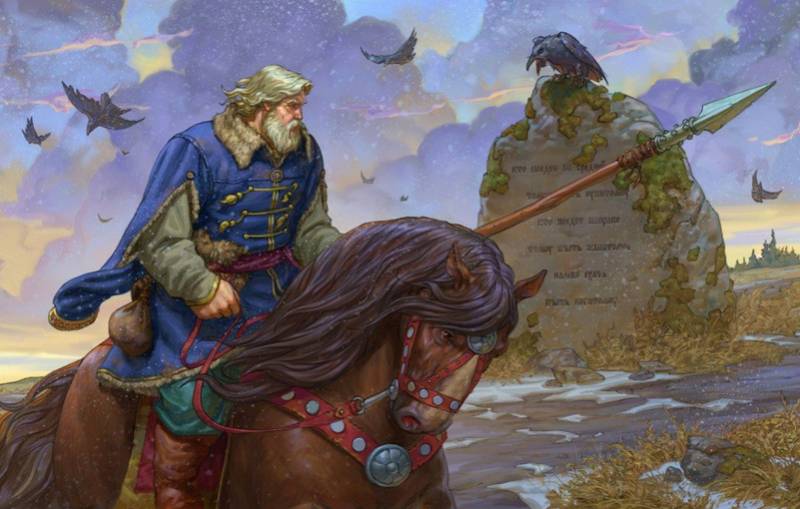
Lonely "old Cossack" Ilya Muromets illustrated by S. Gilev
Some epics tell of how Ilya, who had gone on a campaign, was forgotten at the Kiev court and was not recognized upon his return. Offended, Ilya then even led a popular uprising against Prince Vladimir.
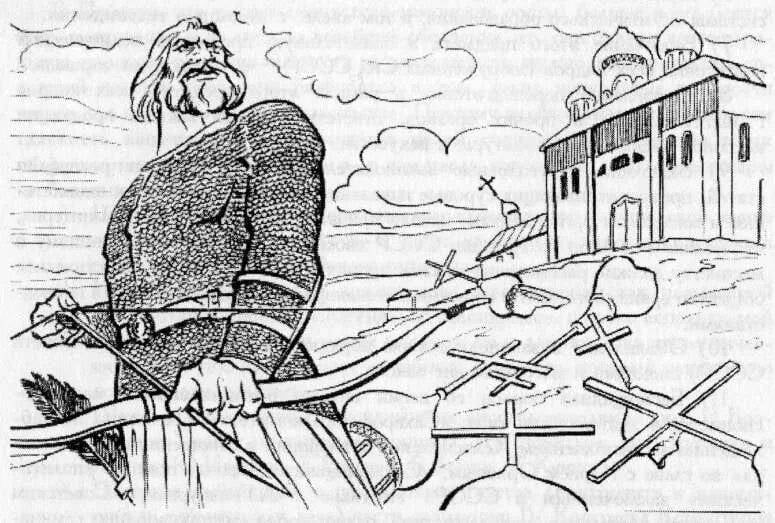
The anger of Ilya Muromets in the drawing by K. Vasiliev (illustrate the epic "Ilya Muromets in a quarrel with Prince Vladimir")
It is about the second, "peasant" Ilya Muromets that is discussed in the poem by A. K. Tolstoy:
I don't hold on to peers
I'm a little unpretentious man
There would be bread cous!
But you surrounded me
In my turn -
So walk my dear
Take Ilya away!
Say the truth, for the prince
I'm not fit for the yard
Take a walk around the world again
Without that, it's time."
And this is the most beloved image of this hero among the people.
Legends about this, the second, Ilya Muromets, probably appeared later than other Russian epics. You can even guess the time of their occurrence. The onslaught of the Polovtsy on the southern lands of Kievan Rus led to an outflow of the population of these places to the northeast, which was originally settled by immigrants from Novgorod.
Epics about the “second Muromets” remember the period when there was no direct road from Murom to Chernigov, and it was Ilya who allegedly paved this path. And the roads to Kyiv and Chernigov began to be cleared in the impenetrable Bryn forests around the middle of the XNUMXth century. The importance and influence of the northeastern Russian principalities grew steadily. It is on the Prince of Vladimir Vsevolod that the author of the Tale of Igor's Campaign places special hopes in protecting Kievan Rus from the Polovtsy, and it is from here, from Zalessky Rus, that his main defender now comes to Kyiv in epics.
In the next article, we will talk about geography in two epics of the Kyiv cycle that stand apart (about Nightingale Budimirovich and Duke Stepanovich) and about the geography of Novgorod epics.
Information